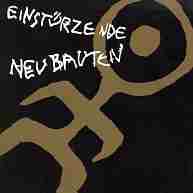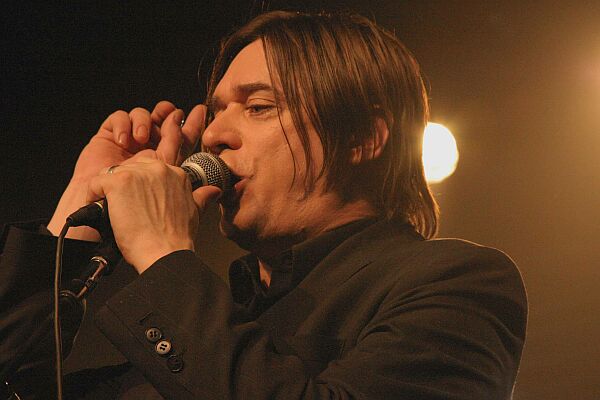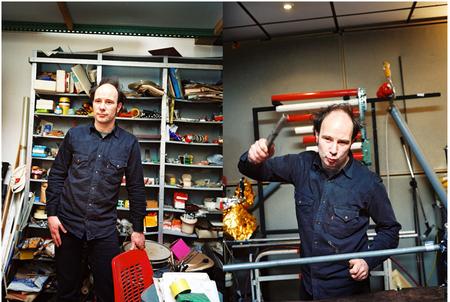NEUBAUTEN’S MESSTHETICS NOW
Wed. April 6, 2005Categories: Abstract Dynamics
Einsturzende Neubauten’s performance last night at the Forum in Kentish Town was an unequivocal triumph, as inspiring as the confederacy of idiocy surrounding the Pope’s death has been depressing.

It’s worth comparing Neubauten’s trajectory to that of Scritti Politti (after all, who exemplifies ‘messthetics’ better than EN?) Neubauten are in many ways the last surviving group from the immediate postpunk era, but where Scritti have embraced the mainstream, with diminishing returns both sonically and commercially, Neubauten have defiantly avoided incorporation. To be honest, I lost contact with them after Haus der Luge, but if there was a trend towards less conspicuous experimentalism on their later recordings, there was no question, as with Scritti, of repudiation of the MO establised on their earliest work. Neubauten’s joyful return to that material last night was at the other extreme from Green’s sniffiness about the Early Scritti. A few years ago, Green’s standoffishness might have sounded like the voice of mature ‘realism’, just as the idea of men in their forties still beating metal might have seemed ‘sad’. Now, Green’s disavowal of messthetics just looks like betrayal, and Neubauten’s holding of the line fidelity.
Both groups began in peripheral zones of cultures still dominated by WWII. Scritti were holed up in a country that had limped on, its empire disintegrated, with a cultural and physical infrastructure defiantly unchanged in many important respects since 1945. Neubauten coalesced in a rebuilt West Germany that needed to be amnesiac about anything preceding 1945. In Britain, the power elite remained esconced in the rotting splendour of old buildings; in West Germany, they occupied new constructions. It was, therefore, new buildings that Neubauten would set out to collapse: not, naturally, to recover some ur-authenticity beneath or beyond the modern city, but to remind us that the cosmos can never stop being a building site.
Nowhere is the opposition between Modernism and Modernization more apparent than in Neubauten’s messthetic. The temporality of Modernization is that of reproductive futurism: its vast pyramidal SF constructions are the very epitome of Gleamprog. Modernism, however, seeks to dismantle both future AND past to get to Now. That’s why its locale is not the ‘high tower’ of SF, but the ‘street’ of cyberpunk, the zone where necessity is the mother of improvisation, where machinic pragmatics trump order and organization. What Neubauten were doing in Berlin, hip-hoppers were doing in New York: ignoring the aesthetic prescriptions demanded by ‘music’, and making it an open question as to how sonic intensities are produced, rewiring the city and reconstructing it as a Partch-work of little machines. The idealized musical object (deemed to be undecomposable because composed) is rematerialized as a set of potentials, machine parts to be recombined at will. What makes this matter, for Neubauten as for hip-hop (then if not now), is that the questions they pose are not academic; the proof of the pudding is in the beating, and Neubauten’s sonic junk sculptures are sublimely compulsive. Listen, now, to their earliest recordings on the outstanding Strategies Against Architecture; they are far less ‘difficult’ than listening to the Stereophonics, honestly, in that they stimulate your nervous system rather than send it to sleep. These were genuine experiments — things could do wrong, discoveries could be made. That’s something far different from the safe refuge of Wire-feted Experimentalism, which is as generically hidebound and untroublingly predictable as boyband chartopop.
My opening contrast of Neubauten with the Pope is not idle rhetoric. Thomite Catholicism is based upon the Aristotlean conviction that the universe has been designed, and that each created thing in has a specific purpose. As Biba Kopf argued in his sleevenotes for Haus der Luge, what Neubauten dismantle is harmony at every level: organismic, social, cosmic. Musical harmony is theological and ideological: the image of a universe that has already been constructed, not of one still under construction.

There are still, gratifyingly, some people who want to see the World we’re forced to live in collapsed. The crowd tonight – no surprises here – are almost all dressed in different shades of black; there’s a refreshing paucity of moody teenage boys, and no baseball caps. Bargain! The atmosphere is highly congenial, and not only because of the density of Goth women, the last remnants of Glam’s aristocracy. We all wait with a quiet expectancy. After the band have started, it takes me a while to realise that the usual London gig irritants – idiots pushing past to get to the bar or conducting conversations throughout – are absent. Everyone is itent.
The band take the stage and Blixa transfixes your attention already. The women swoon for him (including the Italian I’m standing next to, who looks like a Goth version of Sophia Loren [no, really…]), and rightly so. Kopf described him as the Berlin Dandy of the Apocalypse, a description that fits him better the older Blixa, resplendent in three piece suit and black nail varnish, now that he’s lost the consumptive-anorexic thinness and DIY-hacked haircuts. He holds court easily, regaling us with anecdotes (including one about their former bass-player, Marc Chung, who, improbably, now holds a senior executive position in Sony Europe. When EN were between contracts, they approached Chung, who said, ‘Well, maybe: send a demo.’)
They start the first of two retrospective sets with ‘Yu Gung’, and Bargeld is immediately Duchamp-transformed from handsome raconteur into an Artaud-howling scream-machine, his trademark vocal tic, that atonal screech – which sounds halfway between electronic feedback and a dog yelp – magnificently offset by the metallic swarming of the backing track. The physicality of the sound is something that can only be experienced live: for all their power, the records are mere fading coals of the stage inferno.
Perfomance is about the capacity to entrance by entering into a trance. It is good to be reminded in the era of Robbie and (still!) Bono, that no amount of posturing and meta-mugging can substitute for that. Neubauten have two trance modes: metallic-rhythmic and suspenseful-droning. Andrew Unruh’s punitive-addictive rhythmic pulse is crucial to the first. He is a cheerful rhythm-technician, rightly delighting in what his beatmachines can produce. What is notable about alll the band, in fact, is their eminent lack of portentousness. The black clothes are not the pantomime dress beloved of generic Goth-Industrialists, they are a neutral canvas, a wiping away of the postmodern world’s excessive brightness.

This is Pop with only the vaguest relationship to rock, a Pop which has its roots in Stockhausen rather than Presley, Duchamp rather than Robert Johnson. And why not? The very early material makes its own case more powerfully than ever, electrifying the crowd. If ‘O Superman’ could top the charts, why not the tense astropop of ‘Kalte Sterne’? Mid-eighties tracks like ‘Sehnsucht’ and ‘ZNS’ (the latter played live for the first time on this tour) possess a suffocating intensity that makes my teeth grit, my knees weak. Of course you can dance to them.
Reproductive futurists want to build homes for the future.
We’ve been inside, we don’t like it.
We want production spaces, not domestic show homes.
Sparks flew, and not only literally.